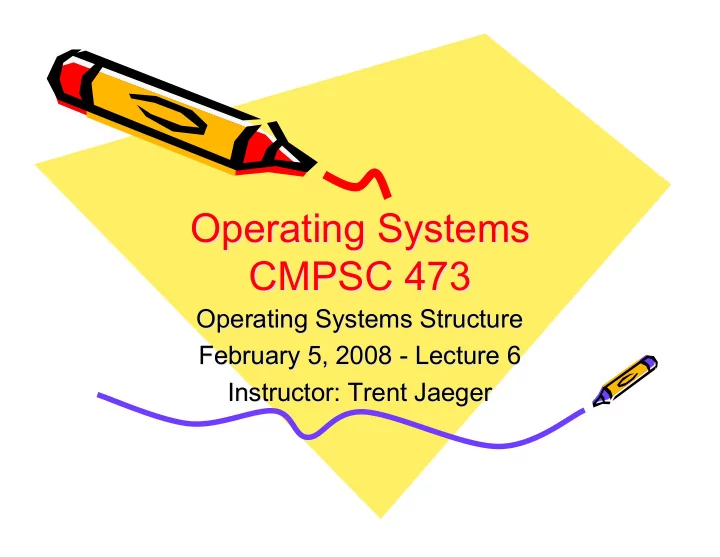

Operating Systems Operating Systems CMPSC 473 CMPSC 473 Operating Systems Structure Operating Systems Structure February 5, 2008 - Lecture 6 6 February 5, 2008 - Lecture Instructor: Trent Jaeger Instructor: Trent Jaeger
• Last class: – Processes • Today: – Threads
Why Threads?
Advantages of Threads • Improve Responsiveness – Ideally, a thread is always ready • Resource Sharing – All the stuff is easily accessible • Economy of Resources – Thread resources are cheaper than process resources • Utilization of Multiprocessors – Get all of them running
Multi-Threaded vs. Single- Threaded
Terminology • Multiprogramming – Run multiple processes concurrently on a single processor – OS choose which process to run out of multiple • Multiprocessing – Run multiple processes on multiple processors – OS manages mapping of processes to processors • Multithreading – Define multiple execution contexts in a single address space – OS manages mapping of contexts (threads) to an address space – OS manages mapping of threads to processor(s)
What’s a Thread? • Thread of Execution on CPU – Program counter – Registers • Memory – Address space (process) – Stack -- per thread • I/O – Share files, sockets, etc. (process)
Working with Threads • In a C program – main () procedure defines the first thread – C programs always start at main • Create a second thread – Allocate resources to maintain a second execution context in same address space • Think about what process fields will be necessary for a thread – Supply a procedure name to start the new thread’s execution
Why Threads vs. Processes • Easier to create than a new process • Less time to terminate a thread than a process • Less time to switch between two threads within the same process • Less communication overheads – Communicating between the threads of one process is simple because the threads share everything: address space
Which is Cheaper? • Create new process or create new thread (in existing process) • Context switch between processes or threads • Interprocess or inter-thread communication • Sharing memory between processes or threads • Terminate a process or terminate a thread (not last one)
Threading Models
Threading Models • Programming: Library or system call interface – User-Space Threading • Thread management support in user-space library • Linked into your program – Kernel Threading • Thread management support in the kernel • Invoked via system call • Scheduling: Application or kernel scheduling – May create user-level or kernel-level threads • NOTE: CPU only runs kernel threads!
User-Space Threads • Thread management support in user-space library – Sets of functions for creating, invoking, and switching among threads • Linked into your program – Thread libraries • Examples – POSIX Threads (PThreads) – Win32 Threads – Java Threads
Kernel Threads • Thread management support in kernel – Sets of system calls for creating, invoking, and switching among threads • Supported and managed directly by the OS – Thread objects in the kernel • Nearly all OS support a notion of threads – Linux -- thread and process abstractions are mixed – Solaris – Mac OS X – Windows XP – …
Many-to-one Thread Model • Many user-level threads correspond to a single kernel thread – Kernel is not aware of the mapping – Handled by a thread library • How does it work? – Create and execute a new thread – Upon yield , switch to another thread in the same process • Kernel is unaware – Upon wait , all threads are blocked • Kernel is unaware there are other options • Can’t wait and run at the same time
One-to-one Thread Model • One user-level thread per kernel thread – A kernel thread is allocated for every user-level thread – Must get the kernel to allocate resources for each new user-level thread • How does it work? – Create new thread, including system call to kernel – Upon yield , switch to another thread in system • Kernel is aware – Upon wait , another thread in the process may run • Only the single kernel thread is blocked • Kernel is aware there are other options in this process
Many-to-many Thread Model • A pool of user-level threads maps to a pool of kernel threads – Pool sizes can be different (kernel pool is no larger) – A kernel thread is pool is allocated for every user-level thread – No need for the kernel to allocate resources for each new user-level thread • How does it work? – Create new thread (may map to kernel thread dynamically) – Upon yield , switch to another thread in system • Kernel is aware – Upon wait , another thread in the process may run • If a kernel thread is available to be scheduled to that process • Kernel is aware of the mapping between process threads and kernel threads
Summary • Threads – A mechanism to improve performance and CPU utilization • Kernel and User-space threads – Kernel threads are real, schedulable threads – User-space may define its own threads (but not real) • Threading Models and Implications
• Next time: More Threads
Recommend
More recommend